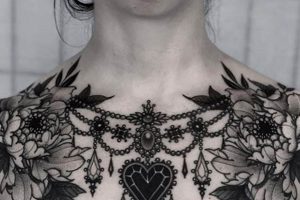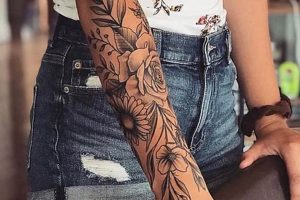Leg tattoos for women offer a canvas for diverse artistic expression, ranging from delicate floral designs to bold geometric patterns and intricate illustrative pieces. The leg provides ample space for larger designs or a series of smaller, interconnected tattoos, allowing for creativity and personalized storytelling.
Placement on the leg allows for a degree of control over visibility. A thigh tattoo can be easily concealed, while a design on the calf or ankle offers the option of display or coverage depending on attire. Historically, leg tattoos have held cultural significance in various societies, symbolizing status, spirituality, or group affiliation. In modern times, they serve as a powerful form of self-expression and personal adornment. Leg placement also offers varied contours, allowing artists to work with the natural curves of the body to enhance the visual impact of the design.
Factors to consider include design size and complexity, desired placement (thigh, calf, ankle), pain tolerance levels associated with different areas, and the artistic style of the chosen tattoo artist. Exploring various design motifs, understanding the healing process, and engaging in thorough consultations with reputable artists contribute to successful and satisfying outcomes.
Tips for Leg Tattoos
Careful consideration of several factors contributes to a successful and aesthetically pleasing leg tattoo.
Tip 1: Research Tattoo Artists: Thorough research is crucial. Examine portfolios, focusing on artists specializing in preferred styles. Seek recommendations and reviews to ensure quality artistry and hygienic practices.
Tip 2: Design Placement and Size: Consider the leg’s contours when selecting placement. Larger designs suit the thigh, while smaller, intricate pieces may be better suited to the ankle or calf. Factor in visibility preferences and clothing choices.
Tip 3: Pain Tolerance: Different areas of the leg have varying levels of sensitivity. Research pain levels associated with specific locations to prepare accordingly. Consult with the chosen artist for advice and pain management strategies.
Tip 4: Design Choice and Meaning: Reflect on personal style and desired message. Explore various motifs, symbolism, and artistic styles to ensure the design resonates personally and remains meaningful over time.
Tip 5: Aftercare Instructions: Proper aftercare is essential for healing and longevity. Follow the artist’s instructions meticulously, including cleaning, moisturizing, and sun protection.
Tip 6: Budget Considerations: Tattoo costs vary based on size, complexity, and artist experience. Establish a realistic budget beforehand to avoid financial strain and ensure a quality piece within budget constraints.
Tip 7: Consultations and Collaboration: Engage in open communication with the chosen artist. Discuss design ideas, placement options, and any concerns. Collaboration ensures a personalized design that aligns with individual preferences.
Careful planning and collaboration with a skilled artist will lead to a beautiful, well-executed leg tattoo that enhances personal style and provides lasting satisfaction.
By considering these factors, individuals can embark on the tattoo journey with confidence, ensuring a positive experience and a cherished piece of body art.
1. Placement (thigh, calf, ankle)
Tattoo placement on the leg significantly influences the overall aesthetic and practicality of the design. Consideration of thigh, calf, and ankle locations allows for a strategic approach that complements body shape, lifestyle, and desired visibility.
- Thigh Placement
The thigh offers a larger canvas suitable for intricate designs, allowing for detailed artwork and bolder statements. This placement allows for easier concealment under clothing. The thigh’s musculature also provides a dynamic surface, allowing designs to flow with the body’s natural contours. Considerations include pain sensitivity, which tends to be lower on the outer thigh compared to the inner thigh.
- Calf Placement
The calf provides a balanced canvas for medium-sized designs. Its visibility can be easily controlled depending on clothing choices. The calf’s muscular structure offers a firm surface for detailed work, although the curvature can present design challenges. Pain levels are generally considered moderate in this area.
- Ankle Placement
The ankle offers a delicate and visible area ideal for smaller, more intricate designs. This placement emphasizes elegance and draws attention to the lower leg. However, the limited space requires careful consideration of design complexity. The ankle’s bony structure can increase pain sensitivity during the tattooing process.
- Wrap-Around Designs
Designs can flow across multiple areas, such as a piece that begins on the thigh and continues down the calf, creating a cohesive and visually striking effect. This approach allows for larger, more narrative pieces that utilize the leg’s entire length. Careful planning is essential to ensure a harmonious transition between body contours.
Ultimately, the choice of placement contributes to the overall impact and personal significance of the tattoo. Careful consideration of these factors ensures a design that harmonizes with the individual’s body and complements their aesthetic preferences. Placement also dictates the visibility and ease of concealment, factors which play a role in personal and professional contexts.
2. Size and Scale
Size and scale are fundamental considerations in leg tattoo design, impacting both aesthetic appeal and the successful execution of artistic concepts. Appropriate scaling ensures the chosen design harmonizes with the leg’s contours and the individual’s physique, maximizing visual impact and longevity.
- Small-Scale Designs
Small tattoos offer subtlety and elegance, often placed on the ankle, foot, or inner calf. These designs can be intricate and detailed or minimalist and symbolic, serving as discreet personal statements. Examples include small floral motifs, geometric patterns, or single-word inscriptions. The limited scale necessitates careful linework and precise detailing for a successful outcome.
- Medium-Scale Designs
Medium-sized tattoos provide a balance between detail and impact, suitable for the calf or outer thigh. These designs allow for greater complexity, incorporating more elaborate imagery or textual elements. Examples include portraits, animal depictions, or more extensive floral arrangements. Careful consideration of placement and proportion is essential to avoid a cramped or disproportionate appearance.
- Large-Scale Designs
Large tattoos create bold visual statements, typically spanning the thigh or encompassing the entire leg. These designs offer ample space for intricate detail and complex compositions. Examples include full-leg sleeves, large-scale portraits, or expansive landscapes. Planning and execution require significant artistic skill and commitment due to the scale and complexity involved.
- Proportion and Placement
The relationship between tattoo size and leg placement is crucial. A large design on a small calf might appear overwhelming, while a small, intricate design might get lost on the vast expanse of the thigh. Careful consideration of scale in relation to chosen placement ensures the design complements the body’s natural contours and achieves the desired aesthetic effect.
Ultimately, the choice of size and scale depends on individual preferences, the complexity of the chosen design, and the desired level of visibility. A well-scaled tattoo harmonizes with the leg’s anatomy, creating a balanced and aesthetically pleasing composition that enhances the wearer’s personal style.
3. Style and design
Style and design are integral to leg tattoos, impacting aesthetic appeal and personal expression. A thoughtfully chosen style enhances the tattoo’s visual impact and reflects individual preferences, creating a piece of body art that resonates deeply. Diverse artistic styles cater to various tastes, ensuring a personalized and meaningful result. The interplay between design elements and leg placement creates a cohesive and visually striking composition.
Various styles, each with unique characteristics, offer a range of options. Realism focuses on detailed and lifelike depictions, capturing intricate textures and shading. Watercolor tattoos mimic the fluidity and vibrancy of watercolor paintings, creating dreamlike and ethereal effects. Geometric designs emphasize precise lines and shapes, resulting in structured and visually arresting patterns. Traditional styles draw inspiration from classic tattoo motifs, often incorporating bold lines and vibrant colors. Floral designs range from delicate and intricate botanical illustrations to bold and stylized floral arrangements. Script tattoos feature elegant lettering and calligraphy, allowing for personalized messages or meaningful quotes. Choosing a style aligned with personal aesthetics and the desired message ensures a tattoo that holds lasting significance.
Selecting a cohesive style and design is crucial for a successful leg tattoo. Factors such as the individual’s personal style, the desired message, and the leg’s contours should guide decision-making. A harmonious blend of these elements results in a tattoo that is both visually appealing and personally meaningful. Consulting with experienced tattoo artists helps individuals navigate style choices and ensures a design that complements their vision. A well-executed design, informed by careful consideration of style and placement, transforms the leg into a canvas for self-expression and artistry.
4. Pain Management
Pain management is an integral aspect of leg tattooing, directly influencing the overall experience and outcome. The leg presents varying levels of sensitivity depending on the specific location, impacting pain perception and tolerance. Understanding these variations and employing appropriate pain management strategies is crucial for a comfortable and successful tattooing process. Ignoring pain management can lead to increased discomfort, muscle tension, and potentially compromised results due to involuntary movements.
Several factors contribute to pain levels during leg tattooing. Bony areas like the ankle and knee tend to be more sensitive than fleshier areas like the thigh. The inner thigh and areas closer to the groin are generally considered more sensitive due to increased nerve endings. Individual pain thresholds also play a significant role, influenced by factors such as previous tattoo experience, overall health, and emotional state. Effective pain management strategies can mitigate discomfort and improve the overall experience. Topical anesthetic creams can numb the area before and during the procedure. Over-the-counter pain relievers like ibuprofen can help manage inflammation and discomfort. Deep breathing techniques and mindfulness exercises can help manage anxiety and distract from pain sensations. Open communication with the tattoo artist is essential. Experienced artists can offer advice on pain management techniques and adjust their approach to minimize discomfort. They can also provide breaks during the session as needed.
Proactive pain management contributes significantly to a positive and successful leg tattoo experience. By understanding pain variations across different leg areas and utilizing appropriate strategies, individuals can minimize discomfort and ensure optimal conditions for the artist to execute the design effectively. Preparation, communication, and appropriate pain management techniques contribute to a more relaxed and ultimately more satisfying tattooing process, resulting in a cherished piece of body art. Disregarding pain management can negatively impact the experience, potentially leading to increased stress, involuntary movements, and a less enjoyable outcome. By prioritizing pain management, individuals can approach the process with greater confidence and ensure a more positive and fulfilling result.
5. Artist Selection
Artist selection is paramount when considering a leg tattoo. A skilled artist translates concepts into visually compelling and technically sound realities. The synergy between artist expertise and individual vision ensures a leg tattoo that reflects personal style and adheres to high artistic standards. Choosing the right artist is crucial for realizing the desired aesthetic and ensuring a safe and positive experience.
- Portfolio Examination
A thorough review of an artist’s portfolio provides crucial insights into their style, technical proficiency, and specialization. Focus on artists whose portfolios demonstrate experience in the desired style, whether it’s realism, watercolor, geometric, or traditional. Assess line quality, color saturation, composition, and overall aesthetic appeal. A strong portfolio reflects consistent quality and artistic vision. For leg tattoos, examine how the artist incorporates designs onto the leg’s curves and contours.
- Specialization and Style
Different artists specialize in various tattoo styles. Matching artistic style with individual preferences ensures a cohesive and satisfying outcome. Research artists known for specific styles, such as fine line, blackwork, or neo-traditional. For example, a realistic portrait requires an artist skilled in capturing intricate details and achieving lifelike representation, while a watercolor tattoo demands an artist adept at blending colors and creating fluid transitions. Aligning artistic specialization with desired style maximizes the chances of achieving the desired aesthetic.
- Hygiene and Safety Standards
Maintaining stringent hygiene and safety protocols is non-negotiable in tattooing. Research studios with impeccable hygiene practices, including proper sterilization of equipment and adherence to universal precautions. Inquire about the artist’s licensing and certification. A safe and sterile environment minimizes risks associated with bloodborne pathogens and infections. Prioritizing hygiene safeguards health and ensures a positive tattooing experience.
- Consultation and Communication
Effective communication between the client and artist is crucial. A thorough consultation allows for open discussion of design ideas, placement considerations, and desired outcomes. A skilled artist actively listens to client preferences, offers professional insights, and ensures a shared understanding of the project. Clear communication fosters collaboration, facilitates creative problem-solving, and ensures the final design aligns with the client’s vision. Open dialogue also allows for addressing any concerns and establishing realistic expectations regarding the process and outcome.
Selecting the right artist significantly impacts the final result and overall satisfaction with a leg tattoo. Careful consideration of portfolio, specialization, hygiene practices, and communication style ensures a positive experience and a leg tattoo that reflects personal style and artistic excellence. A well-chosen artist acts as a collaborative partner, translating individual vision into a beautiful and enduring piece of body art.
Frequently Asked Questions
This section addresses common inquiries regarding leg tattoos for women, offering factual information and practical guidance for those considering this form of body art.
Question 1: How does leg placement affect tattoo visibility?
Placement dictates visibility. Thigh tattoos are easily concealed, while calf and ankle tattoos offer more visibility depending on attire. Consider lifestyle and professional contexts when choosing placement.
Question 2: What factors influence pain levels during leg tattooing?
Pain levels vary based on location and individual pain thresholds. Bony areas (ankle, knee) tend to be more sensitive than fleshier areas (thigh). Inner thigh areas are generally more sensitive due to increased nerve endings.
Question 3: How long does a leg tattoo take to heal?
Healing typically takes 2-4 weeks, varying based on size, complexity, and individual healing rates. Proper aftercare, including keeping the tattoo clean and moisturized, is crucial for optimal healing and color vibrancy.
Question 4: How should one choose a reputable tattoo artist?
Thorough research is essential. Examine portfolios, focusing on artists specializing in the desired style. Check reviews and testimonials, prioritizing artists with demonstrably safe and hygienic practices. Consultations are crucial for discussing design, placement, and any concerns.
Question 5: What design elements work well for leg tattoos?
Various design elements can complement the leg’s contours. Floral designs, mandalas, geometric patterns, and illustrative pieces can be adapted to flow with the leg’s shape. Consider the leg’s natural curves and musculature when choosing a design.
Question 6: How can one estimate the cost of a leg tattoo?
Cost depends on size, complexity, artist experience, and studio location. Consultations provide accurate cost estimates. Establish a realistic budget beforehand to avoid financial strain and ensure quality artistry within budget constraints.
Careful consideration of these factors contributes to a positive and informed decision-making process. Further research and consultation with reputable tattoo artists provide personalized guidance tailored to individual needs and preferences.
Further sections will delve into specific design inspirations and aftercare instructions.
Conclusion
Exploration of leg tattoos for women reveals the diverse possibilities for personal expression and artistic representation. Careful consideration of placement, size and scale, style and design, pain management, and artist selection contributes significantly to a successful and satisfying outcome. Placement choices range from the discreet elegance of ankle tattoos to the bold statements offered by thigh pieces. Design styles span a spectrum from delicate floral motifs to intricate geometric patterns and powerful illustrative narratives. Understanding pain variations across leg areas and employing appropriate management strategies ensures a comfortable tattooing experience. Thorough research and artist selection based on portfolio, specialization, and hygiene practices are crucial for realizing desired artistic visions. The leg, as a canvas, offers a dynamic interplay between body contours and artistic expression, allowing for deeply personal and visually compelling body art.
Ultimately, leg tattoos offer women a powerful medium for self-expression and storytelling. The fusion of artistic vision and anatomical canvas creates a lasting testament to personal narratives, aesthetic preferences, and individual journeys. A well-chosen leg tattoo becomes an integral part of personal identity, reflecting individuality and evolving alongside personal growth. The commitment to thoughtful planning and collaboration with skilled artists ensures a timeless piece of art that resonates deeply and continues to inspire.







